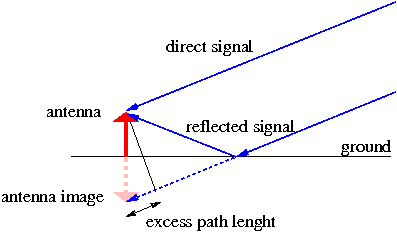What is GNSS multipath?
FIXPOSITION’s description of multipath environment
At FIXPOSITION we consider a multipath environment any scenario where the receiver antenna has a partially blocked view of the sky and there are structures in the surroundings that will potentially reflect the GNSS signals. Some examples of multipath environments can be the street in a city, a dense forest or even under a bridge.
Introduction
Multipath is a major error source for Global Navigation Satellite System (GNSS) receivers. This effect is a result of the reflection of GNSS signals on surfaces surrounding the receiver antenna. The size of the error depends on the position of the satellites; the position of the receiver antenna; and the shape, size, and material of the surroundings.
Context
GNSS receivers measure the distance between the receiver antenna and each satellite to compute the position. This distance is computed from the time it takes the signal to propagate from the satellite to the receiver. Ideally, this distance should be a straight line between satellite and receiver antenna, any deviation from that straight line introduces an error in the measurement and, hence, an error in the position estimate.
Why multipath happens
GNSS signals will be reflected on the surfaces surrounding the receiver antenna. These reflected signals cause an apparent longer path between the receiver and the satellite. A GNSS receiver will receive the direct signal (known as Line-Of-Sight, LOS) if the satellite is directly visible. It can also receive one or multiple reflected signals (known as Non-Line-Of-Sight, NLOS), depending on the surroundings of the antenna. The addition of these LOS and NLOS signals causes an unknown error in the measurement. This error depends on many varied factors, and it cannot be predicted. For this reason, it cannot be corrected, and it is one of the major error sources in GNSS position. Usually, the receivers try to detect which signals have multipath and exclude these measurements from the estimation of the position.
 Difference of the optical path between the direct signal and the reflected signal. Image source |
Both the magnitude of the error due to multipath, and the capacity of the receiver to exclude the “bad” measurements depend on the number of signals affected by multipath. If the receiver observes many signals but only a few of them have multipath, the receiver will more easily reject these “bad” signals and if some are not rejected, its effect will be small in the position estimation. On the other hand, if most of the signals are affected by multipath, it will be hard for the receiver to discern which are the good signals and the error on the position will probably be larger.
Other factors that affect the magnitude of the multipath error are the type of material of the structures surrounding the receiver antenna and the distance to these structures. Some of the materials that reflect the most are metals (or any electricity conductor), glass and ceramic; PVC and wood can also be good reflective materials. In regards of the distance to the structures, we can distinguish two types of multipath:
Short multipath refers to the signals reflected on structures that are close to the receiver antenna, typically up to a few meters. The error introduced in the measurements is relatively small but hard to detect. This error will also change quickly as the receiver moves if the reflecting surfaces are not fixed to the receiver. It is important to consider that short multipath can also be caused by reflective surfaces on the platform where the receiver is attached, especially if these surfaces are not below the receiver antenna.
Long multipath refers to the signals reflected on surfaces farther from the receiver antenna. These reflected signals will typically have less power and the measurements affected will be easier to reject. However, if a measurement affected by long multipath is not rejected, it will heavily degrade the position estimate.
Multipath, NLOS and shadowing
The problem known as multipath can be caused by different situations:
LOS and NLOS: The LOS signal is received but other NLOS signals are also received at the same time. The receiver cannot tell if it is receiver multiple signals, the measurement obtained by the receiver is an “average” of the LOS and NLOS signals.
NLOS only: When the LOS signal is completely blocked but one or multiple NLOS signals are received.
Shadowing: The LOS signal is received but it has gone through some “translucent” obstacle (e.g., tree canopies). The receiver will have a challenging time to precisely measure the distance. If other NLOS signals are also received, it only makes it worse.
 Different effects on the GNSS signal in a multipath environment. Image source |
Scenarios prone to multipath
From the previous description of the multipath effect, we can then summarize the different factors that will have an impact on the amount and magnitude of multipath.
Satellite elevation: The lower the satellite is with respect to the receivers, the more obstacles the signal can find during propagation. Lower elevation satellites are then more prone to be affected by multipath.
Antenna: Reflected signals will typically arrive from the sides of the antenna, and not from the top. There are then some types of antennas which highly attenuate the signals coming from the side. These types of antennas have been shown to reduce the multipath error, but they also come at a higher cost.
Nature of the receiver surroundings:
Urban canyon: Typically, the worst scenario in terms of multipath. The taller the buildings, the bigger the problem since larger portion of the total of signals is affected by multipath.
Forests: lots of shadowing by tree canopies.
Valleys/natural canyons: Mountains and other geological features can also cause multipath.
The material of the surrounding structures also has an impact. For example, metal surfaces reflect much more than rocks.
